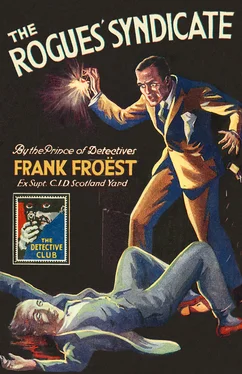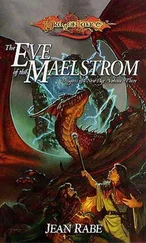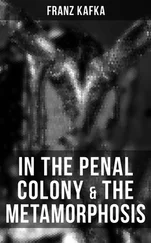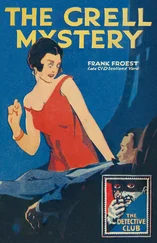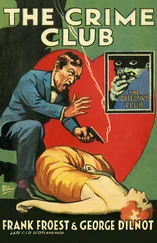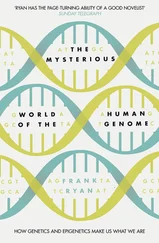‘THE DETECTIVE STORY CLUB is a clearing house for the best detective and mystery stories chosen for you by a select committee of experts. Only the most ingenious crime stories will be published under the THE DETECTIVE STORY CLUB imprint. A special distinguishing stamp appears on the wrapper and title page of every THE DETECTIVE STORY CLUB book—the Man with the Gun. Always look for the Man with the Gun when buying a Crime book.’
Wm. Collins Sons & Co. Ltd., 1929
Now the Man with the Gun is back in this series of COLLINS CRIME CLUB reprints, and with him the chance to experience the classic books that influenced the Golden Age of crime fiction.
COLLINS CRIME CLUB
an imprint of HarperCollins Publishers Ltd
1 London Bridge Street
London SE1 9GF
www.harpercollins.co.uk
First published in Great Britain by Eveleigh Nash 1916
Published by The Detective Story Club Ltd for Wm Collins Sons & Co. Ltd 1930
Cover design © HarperCollins Publishers Ltd 1930, 2018
A catalogue copy of this book is available from the British Library.
This novel is entirely a work of fiction. The names, characters and incidents portrayed in it are the work of the author’s imagination. Any resemblance to actual persons, living or dead, events or localities is entirely coincidental.
All rights reserved under International and Pan-American Copyright Conventions. By payment of the required fees, you have been granted the non-exclusive, non-transferable right to access and read the text of this e-book on screen. No part of this text may be reproduced, transmitted, down-loaded, decompiled, reverse engineered, or stored in or introduced into any information storage and retrieval system, in any form or by any means, whether electronic or mechanical, now known or hereinafter invented, without the express written permission of HarperCollins.
Source ISBN: 9780008137717
Ebook Edition © May 2018 ISBN: 9780008137724
Version: 2018-04-17
DEDICATED TO
WILLIAM ALLAN PINKERTON,
America’s greatest Crime Investigator, to whom one of the writers will be ever indebted for the great and valuable assistance offered him throughout his official career.
Table of Contents
Cover
Title Page
Copyright
Dedication
Introduction
Chapter I
Chapter II
Chapter III
Chapter IV
Chapter V
Chapter VI
Chapter VII
Chapter VIII
Chapter IX
Chapter X
Chapter XI
Chapter XII
Chapter XIII
Chapter XIV
Chapter XV
Chapter XVI
Chapter XVII
Chapter XVIII
Chapter XIX
Chapter XX
Chapter XXI
Chapter XXII
Chapter XXIII
Chapter XXIV
Chapter XXV
Chapter XXVI
Chapter XXVII
Chapter XXVIII
Chapter XXIX
Chapter XXX
Chapter XXXI
Chapter XXXII
Chapter XXXIII
Chapter XXXIV
Chapter XXXV
The Detective Story Club
About the Publisher
FOR the lover of a really exciting detective story, here is good fare. For those a little tired of New York’s Underworld, here is more familiar ground: west-end streets and restaurants; respectable suburban villas; purlieus of Bloomsbury—an east-end we know to be true. Here are no puppets, but human, vivid figures playing out a drama of love and hate and greed, the sleuths of Scotland Yard hot on their trail and the shadow of the hangman’s noose before their eyes.
Ex-Superintendent Frank Froëst tells his story in a straightforward way. There are no hidden clues, no sudden dénoue-ments to put the reader deliberately on a false trail. He shares the excitement of the hunt, knows all there is to know, and has every chance to spot the murderer and solve the mystery of the forged cheques.
The adventures of Jimmie Hallett are sufficiently exciting in all conscience to satisfy the most exacting of detective story ‘fans’. Against a familiar London background, we have here a tale of breathtaking adventure—knifing, arson, racing-taxicabs, and shooting-to-kill. Can Weir Menzies, that genial detective with the churchwarden manner, even with all the resources of Scotland Yard behind him, succeed in outwitting a gang of international crooks of whose very numbers he is ignorant?
His efforts to unravel the tangle lead him to the unsavoury atmosphere of Shadwell and the docks. His quarry, after slipping through the cordon of police, is run to earth in a Chinese opium den. There is a cellar in Brixton, a furiously-driven taxi with a dead woman for fare—in fact, a constant succession of thrills.
Apart from the tale, to make the acquaintance of Mr Weir Menzies is a pleasure in itself. Weir Menzies, the model husband, the respectable and respected citizen of Tooting, with his dog and his roses and his dislike of late hours; Weir Menzies, with his calm, unhurried manner, refusing to be rushed, refusing to be ruffled, relying on perseverance and dull routine and plain common sense. Surely here is a detective after everyone’s heart.
Detection as a science and not a freak accomplishment is expounded in this story with a wealth of convincing argument. As a vindication of official procedure it is worth reading alone. It is written with genuine knowledge of the methods of police detection, sometimes dull and laborious in themselves: the careful sitting of a mass of irrelevant detail; the intelligent consideration given to the most trivial scrap of information; the interesting survey of the case from time to time by highly-placed officials (the C.I.D. believes firmly that two heads are better than one, and sometimes three than two); then finally the close and oft-repeated scrutiny of the points of the case when it takes definite shape in their hands, to ensure that it is proof against the slings and arrows of the defending counsel.
It is a fact of real life, in this country at least, that a criminal may—and not infrequently does—escape justice, in spite of widespread belief in his guilt, through the inability of the police to bring definite proof in support of their theory. A recent tightening of the law has still further restricted their powers of questioning suspects—never at any time in England have they been permitted to indulge in the protracted and intensive methods of examination in vogue on the continent and in America—and thus made it increasingly difficult to obtain the proofs necessary to bring the criminal to justice.
The Rogues’ Syndicate illustrates clearly the difficulty under which the police sometimes labour in this respect—their inability to obtain sufficient evidence to prove their charge to a jury—and as an intelligent exposition of this aspect of our criminal law should be read with enjoyment by everyone interested in crime and detection.
Accuracy of detail is ensured by the fact that the author, ex-Superintendent Frank Froëst, was over thirty years at Scotland Yard. His triumphs range from his successful round-up of Jabez Balfour in the Argentine in connection with the Liberator frauds to his equally dramatic success in the Crippen case, the sensational arrest of Dr Crippen—in which wireless played an important part being planned by this resourceful detective in his room at Scotland Yard.
THE EDITOR
FROM THE ORIGINAL DETECTIVE STORY CLUB EDITION
April 1930
HALLETT blundered into an unlit lamp-post, swore with fervour, and stood for a second peering for some identifiable landmark in the black blanket of fog that shrouded the street. Where he stood, a sluggish, dense drift had collected, for, following the treacherous habit of London fogs, it lay in patches. About him he could hear ghostly noises of traffic muffled and as from afar, but whether the sounds came from before or behind, from right or left, was more than his bewildered senses could fathom.
Читать дальше
